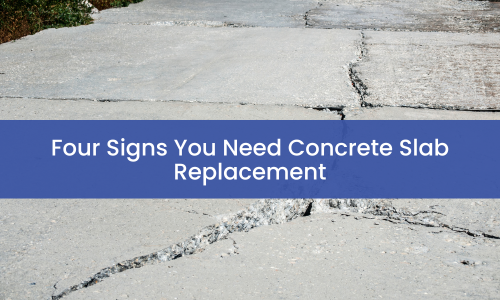If you suspect issues with your concrete slab, here are four signs that you may need concrete slab replacement:
- Uneven concrete or slab that’s “sunken” in places
- Deep, widespread or “working” cracks
- Excessive spalling
- Rust stains or other forms of discoloration
Concrete slab is one of construction’s most durable materials, capable of withstanding decades of weather and wear before it needs to be replaced. It’s an effective long-term investment, but when concrete slabs begin deteriorating, it can cause safety and efficiency issues. If your concrete is showing any of the following signs of damage, it’s time to schedule an expert inspection with a reputable concrete contractor.
1) Concrete Slab That is Uneven, Heaved or Sunken
If concrete slab becomes uneven in areas, it Is typically a sign of an unstable or poorly prepared subgrade. It could also be due to frost-related heaving due to repeated freeze/thaw cycles – though this is a less common cause in Houston. What is more common are expansive clay soils, which can shift a great deal following rainfall, forcing the overlaying concrete slab out of alignment. This can cause safety and traffic problems – and could damage vehicles passing over the pavement’s surface.
There is no way to repair uneven concrete slab, so replacement is generally the recommendation, but only after the existing pavement is removed and the underlying subgrade is addressed. In this instance, addressing the subgrade may include adding additional subgrade materials or stabilizing additives, or compacting the soil. Once the subgrade is stable and has the compressive strength to take concrete, new slab can be installed.
2) Concrete That is Marred by Excessive, Deep or Working Cracks
All concrete eventually cracks, even with high quality materials and workmanship. There is no avoiding them, but if cracking is deep, wide or spreading, there is a cause for concern. Specifically, any cracks that extend through the pavement or are wider than 1/8 inch indicate potential structural issues and likely the need for slab replacement. Cracks that are working, or actively spreading, may also necessitate concrete replacement, depending on the underlying cause.
There can be many reasons why concrete is developing severe cracks. Poor subgrade compaction and stabilization is also a potential cause here. Concrete possesses excellent compressive strength, but it is vulnerable to tensile stresses. In other words, if it is given a strong base to sit on, concrete will withstand extreme loads. However, if that underlying support is uneven, the slab’s flexural strength will be overwhelmed. The only fix is to remove the pavement and correct the base.
Other reasons for excessive cracking include overloading, poor material quality, poor curing practices and water infiltration. Some of these issues may be corrected through repairs, but replacement is often required.
3) Concrete That is Spalling, or Breaking Off in Large Chunks
Spalling refers to concrete that’s breaking off in chunks, and it ranges greatly in severity. Some spalls are surface defects, but they can extend deep enough into the slab to cause structural issues – or at least expose deeper layers to adverse weather conditions. Further, large spalls can affect motorist performance and may therefore present safety risks.
Spalls may form around steel rebar in reinforced concrete as well. If spalls occur around rebar, it could expose the steel to corrosive conditions that may lead to dangerous failures.
There are several potential causes behind spalling. Expansion within the concrete is a primary cause, which itself may be due to corroded steel reinforcement or improper jointing. Other causes of spalling include impact or weather damage, fire damage and chemical attack. If spalling is extensive, repairs will only temporarily correct the problem and the appearance of the concrete. Full slab replacement will be needed to restore the pavement’s durability and performance.
4) Concrete That is Developing Rust Stains
Discoloration may affect the appearance of the concrete, but it rarely results in structural concerns. Minor discoloration is typically due to certain admixtures in the concrete or exposure to various chemicals during the installation process. These can be removed with thorough cleaning and chemical treatment.
However, there is a notable exception to this. If the slab was reinforced with steel and is starting to develop rust stains, there may be corrosion going on under the slab’s surface. In reinforced concrete, steel corrosion is typically caused by chlorides infiltrating the concrete or by carbonation. In both cases, the products of corrosion expand around the rebar, placing the pavement’s top layers under intense tensile stress. Eventually, this will cause the concrete to spall, which can lead to dangerous bursting forces if the rebar fails completely and shears apart.
Before reinforced concrete gets to that point, you may see rust leaking out of holes in the concrete, perhaps around existing spalls or from smaller flaws like bugholes. Once rust is spotted, it is important to have a professional inspect the slab to determine what is causing rust to form, as the slab may be compromised from the inside out and need replacement.
If the Above Signs are Present, Schedule an Inspection with a Reputable Concrete Contractor
When a concrete slab shows signs of distress, either repair or replacement will be needed to restore the pavement’s condition. In many cases, it is impossible to know which one is necessary without extensive experience with concrete.
If your concrete slab has obvious signs of wear or damage, a concrete paving company can perform a full inspection of the concrete and determine the cause of any damage. The experts will then determine whether slab repairs or replacement make more sense. If slab replacement is recommended, a concrete contractor can provide replacement services, along with quality materials and processes.
- Houston Parking Lot Lifecycles: Is It Time to Resurface, Overlay or Replace Your Pavement? - December 5, 2025
- Why Should Asphalt Maintenance in Houston be a Priority for Property Owners? - November 14, 2025
- What Factors Determine the Cost of Asphalt Services in Houston? - October 23, 2025

